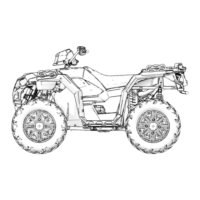4.32
IDLE AIR CONTROLLER (IAC)
OPERATION OVERVIEW
The Idle Air Control (IAC) is used to stabilize idle quality
of the engine at cold start-up and after warm-up
operations.
Mounted on the RH side of the airbox, the IAC contains 1
stepper motor which receives varying voltage signal
pulses from the ECU. These pulses determine the IAC
plunger setting, thereby controlling the amount of air
bypassing the closed throttle body for idle control. If the
IAC is disconnected or inoperative, it will remain at it’s
last operated position.
IAC TEST
The IAC is a non-serviceable item. If it is faulty, it must be
replaced. It can be ‘bench tested’ using the following
method:
Set your meter to read Ohms. Check the resistance
values at each of the following pin locations of the IAC. If
any of the readings are out of specification, replace the
IAC.
PINS RESISTANCE PINS RESISTANCE
1 - 2 30Ω ± 1.2Ω 4 - 5 30Ω ± 1.2Ω
2 - 3 30Ω ± 1.2Ω 5 - 6 30Ω ± 1.2Ω
1 - 3
60Ω ± 2.4Ω
4 - 6
60Ω ± 2.4Ω
IAC REPLACEMENT
1. Remove the seat and upper RH side panel.
2. Disconnect the wire harness from the IAC motor
connector
q
, remove the two hoses from the IAC
valve tubes
w
and remove the screw retaining the
IAC valve to the airbox.
3. Remove the IAC assembly from the airbox by pulling
the IAC tube out of the airbox grommet.
4. If removed with the IAC during removal, install the
rubber grommet back into the airbox.
5. Install the new IAC into the airbox. Lightly lubricate
the IAC tube to aid installation.
6. Position the IAC on the airbox and install retaining
screw.
7. Install the two hoses on the IAC valve.
8. Reconnect the vehicle harness to the IAC motor.
9. Install upper RH side panel and seat.
FUEL SYSTEM

